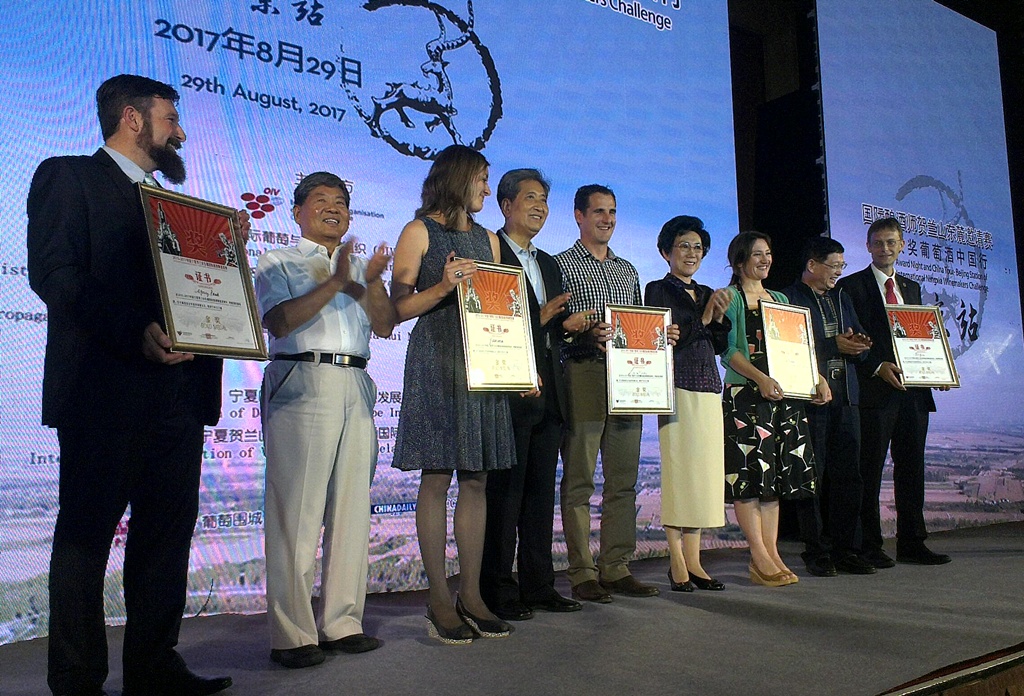By Jim Boyce | Justin Corrans of South African led the gold medal charge during last week’s finale of the Ningxia Winemakers Challenge, a two-year project that saw 48 candidates from 17 countries travel to Ningxia, pair with local wineries for harvest in 2015, and practice their craft.
A ten-member panel judged the 48 NWC wines last week and awarded five gold and ten silver medals. Of the golds, their pick of the day was made by Corrans, who is CEO at Mountain Ridge and paired with winery Lanxuan in Ningxia for the contest.
This week, Corrans was back in Beijing on business and I asked him about the NWC.
What was the biggest challenge of the Challenge?
Practicing my sign language. I had a good translator, but when she left the winery, all communication stopped for a while. We also had issues at the beginning, some butting of heads with one of the consultants, but in the end I got the wine I wanted. You have to look at what’s possible, you have to look at the context.
Everyone got three hectares of grapes in the same vineyard. What was your strategy?
We did a tasting of Ningxia wines [after arriving in Yinchuan] and I found they were good but often had a herbaceous undertone. I wanted to avoid that while juggling other factors, including rain and my own logistics.
Ideally, we would have picked later but harvest generally works against you. We picked half before a rainstorm and the balance a week later. Once the fruit dried out, the analysis for the two groups was remarkably similar.
I also did a bit of a picker’s course before harvest, with instructions like avoid the Cabernet Gernischt, and tried to supervise the pickers. We did a good session on the sorting tables.
And once you got your wine underway?
Because the fruit had relatively high acidity, I was a bit nervous. That delicate fruit could have been overwhelmed with oak, plus we had to consider budget, so we went with four new French barrels. We used some 500-liter barrels and tank material as well.
You’ve made very consumer-friendly wines. Did your NWC wine fit that mold?
It doesn’t have an obvious fresh and fruity character, it isn’t soft and juicy. The tannin structure is what helped set it apart from some of the other wines. There was more extraction. Being concerned about the given flavors, I fermented it quite hot, and I think it worked.
What would be your advice to Ningxia as a wine region?
To have more focus on viticulture, to try to figure out how to manage it. On a smaller point, Ningxia could use a good world-class laboratory so that analysis is more accurate.
Ningxia is largely tied to Cabernet. Any other grapes you think might work?
I tasted some surprisingly good Pinot Noirs, including the 2013 from Lanxuan. Earlier ripening varieties should get more consideration. With late-ripening ones, there is the challenge of pruning and burying the vines before winter arrives.
What was your favorite Ningxia food?
The lamb is always a standout. We are proud of our lamb in South Africa but Ningxia is also very good.
What would you pair with it?
I’d probably pick one of the new-style Cinsaults coming out of South Africa.
Corrans also told me he found similarities in the South Africa and China markets.
“There is so much potential with emerging wine consumers,” he said. “That growing middle class in both countries is where you want to be.”
He said part of Mountain Ridge’s strategy is to focus on shebeens, a kind of bar with grilled meat. That is revealing a market much bigger than typically thought.
“There is a bit of a ‘fear of the unknown market’,” he said. “Some people think you sell wine by sitting down and having a three-course meal. But you need to adapt to the culture, and the traditional African way of doing things presents the flavors all at once.”
This sounds like it might bear some fruit for food and wine in China, where simultaneously enjoying numerous dishes is the norm.
We can also expect to see Corrans in China, especially given that, as CEO of Mountain Ridge, he is eying this market.
“I’d very much like to expand the market for our South African wines,” he said. “I started as CEO three months ago and have been traveling and learning so much since then.”
Follow Grape Wall on Facebook and Twitter. Support the project here. And sign up for the China wine newsletter below. Also check out sibling sites Beijing Boyce and World Baijiu Day.
Grape Wall has no sponsors of advertisers: if you find the content and projects like World Marselan Day worthwhile, please help cover the costs via PayPal, WeChat or Alipay.
Sign up for the free Grape Wall newsletter here. Follow Grape Wall on LinkedIn, Instagram, Facebook and Twitter. And contact Grape Wall via grapewallofchina (at) gmail.com.
